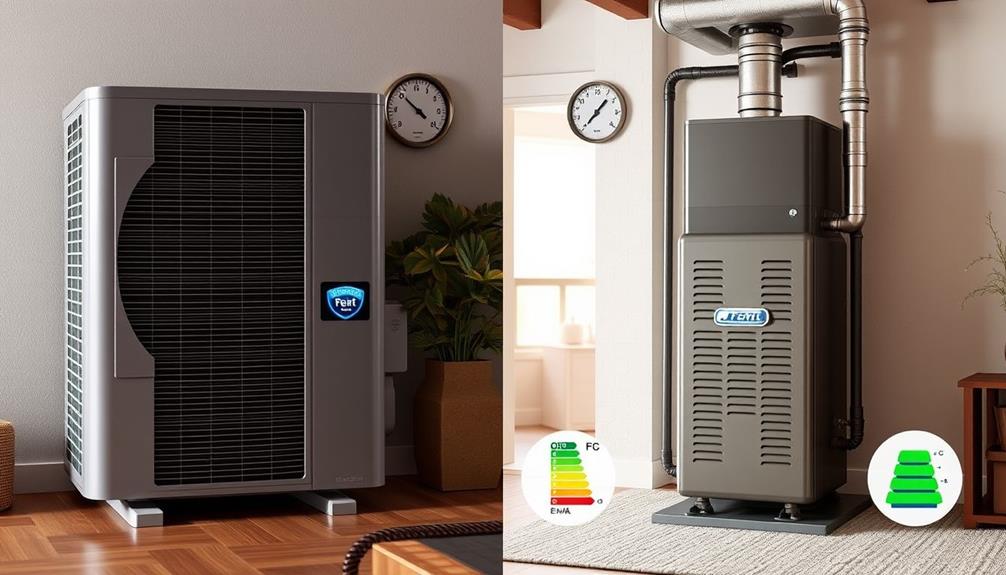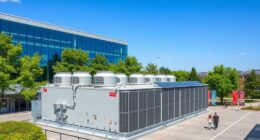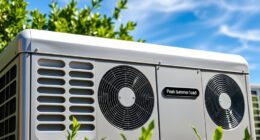Geothermal heat pumps are definitely worth considering if you want to save on energy bills. You can expect to cut heating costs by 30-70% and cooling costs by 20-50%. While the upfront installation costs can range from $10,000 to $40,000, federal tax credits of 22% to 30% can ease that burden. Plus, these systems have a lifespan of over 50 years, offering lasting savings and eco-friendly benefits. Remember, though, that installation can disrupt your landscape temporarily. If you're curious about the finer details, there's much more to uncover about their long-term financial impacts.
Key Takeaways
- Geothermal heat pumps can reduce heating costs by 30-70% and cooling costs by 20-50%, resulting in significant long-term energy savings.
- Upfront installation costs range from $10,000 to $40,000, but federal tax credits of 22% to 30% can offset these expenses.
- Systems have a long lifespan, with underground components lasting over 50 years and mechanical parts lasting 20-25 years, ensuring durability.
- Installation may disrupt landscaping and require excavation, but the long-term savings and efficiency often outweigh short-term inconveniences.
- The payback period varies from 5 to over 20 years, making geothermal systems a potentially wise financial investment depending on local energy prices.
Cost Overview of Geothermal Systems
When considering a geothermal heat pump system, understanding the cost breakdown is essential for planning your investment. The average cost of installing a geothermal system hovers around $24,500, but prices can range from $17,000 to $32,300 based on various factors like system type and installation costs.
Geothermal heat pumps are known for their high efficiency and low operational costs, which can greatly impact your long-term savings. Installation alone can set you back between $8,000 and $24,000, while equipment for heat pumps typically costs between $4,000 and $7,000.
Ductwork installation for forced air systems may add an extra $2,000 to $6,000, and yardwork for excavation or trenching can run you anywhere from $5,000 to $15,000. The system type you choose greatly influences costs. For instance, horizontal loop systems average between $15,000 and $30,000, while vertical loop systems can range from $25,000 to $40,000.
Don't forget about permit costs, which can vary from $100 to over $1,000, depending on local regulations.
Despite the upfront costs, geothermal systems use energy efficiently, leading to long-term savings benefits. Investing in a geothermal heat pump could be a savvy decision that pays off in the long run.
Types of Geothermal Heat Pumps

Geothermal heat pumps are categorized into three main types: closed-loop systems, open-loop systems, and hybrid systems. Closed-loop systems circulate a fluid through buried pipes for heat exchange. Within this category, you'll find vertical systems, which require deeper drilling and generally have higher installation costs, and horizontal systems, which are more cost-effective but need more land space.
Additionally, these systems can provide benefits of diversification in energy sources, similar to how diversifying a retirement portfolio can mitigate risks.
On the other hand, open-loop systems use groundwater directly for heat exchange. They're highly efficient but depend on having a clean water supply; this makes them unsuitable for all properties due to concerns about groundwater contamination.
Hybrid systems combine elements of both closed and open-loop designs, enhancing overall efficiency. These systems adapt to varying conditions, making them versatile for different environments.
When considering geothermal heat pumps, it's crucial to note that they can achieve energy efficiency ratings considerably higher than traditional HVAC systems. You could save 30-70% on heating and 20-50% on cooling costs, making them an attractive option for long-term savings.
Ultimately, the choice among these systems will depend on your specific needs and property conditions.
Factors Influencing Installation Costs

Taking into account the various factors that influence installation costs for geothermal heat pumps can help you make an informed decision. The type of loop system you choose plays an important role. Horizontal systems are generally cheaper, costing between $15,000 and $30,000, while vertical systems can set you back $25,000 to $40,000.
The depth and complexity of excavation necessary for installation also impact costs; vertical systems require deeper drilling, which can increase labor and equipment expenses. Additionally, air quality concerns related to indoor environments may lead you to evaluate a geothermal heat pump as part of a broader strategy for improving overall home comfort.
Moreover, ground conditions such as soil type and moisture content are vital. Softer soils tend to reduce both time and expense, while dense clay or rocky terrain can escalate costs. You might encounter extra expenses from ductwork installations or upgrades, which can range from $2,000 to $6,000 for forced air systems.
Lastly, local factors—like labor rates, contractor availability, and regulatory compliance—can cause installation costs to vary greatly from one location to another. By evaluating these elements, you can better estimate the total investment required for your geothermal system and plan accordingly.
Benefits and Drawbacks

Investing in geothermal heat pumps offers notable benefits alongside some drawbacks that you should evaluate carefully. One of the primary advantages is the significant long-term savings on energy costs. Many homeowners report reductions of 30-70% on heating and 20-50% on cooling expenses compared to traditional systems. This makes the geothermal heating system an attractive option for those looking to lower their monthly bills over time.
Additionally, the energy efficiency of such systems contributes to a reduction in overall carbon footprint, aligning with environmentally friendly practices as noted in gout management insights.
However, the upfront cost can be a deterrent, typically ranging from $10,000 to $40,000. Fortunately, federal tax credits of 22% to 30% can help offset these expenses, enhancing the financial feasibility of adopting this heating and cooling technology.
Another point to evaluate is the longevity of geothermal systems. Underground components can last over 50 years, while mechanical parts usually last 20-25 years, contributing to their value.
Still, installation disruption can be a significant drawback, as the process often involves extensive excavation and can alter your landscaping.
Ultimately, evaluating these benefits and drawbacks will help you decide if a geothermal system aligns with your energy needs and environmental goals.
Long-Term Financial Implications

When evaluating the long-term financial implications of geothermal heat pumps, you'll find that the initial costs can be intimidating, but the potential for considerable savings makes them worth pondering.
The process of harnessing the Earth's heat isn't only efficient but also eco-friendly, contributing to a sustainable energy future. While the initial installation cost typically ranges from $24,500 to $32,300, the benefits can outweigh these expenses over time, particularly when reflecting on the considerable untapped potential for energy generation.
Here are four key points to ponder:
- Long-term savings: You can save 25% to 50% on energy costs, translating to $1,000 or more annually compared to traditional heating and cooling systems.
- Payback period: Depending on local energy prices, you might see a payback period ranging from 5 to over 20 years.
- Federal tax credits: Taking advantage of federal tax credits of 22% to 30% can considerably reduce your overall investment in geothermal heating.
- Durability of geothermal systems: These systems can last over 50 years for wells and 20-25 years for mechanical components, ensuring longevity and reliability.
For homeowners, the combination of energy savings and the durability of geothermal systems makes this investment in geothermal heating a financially savvy choice in the long run.
Frequently Asked Questions
Are Geothermal Heat Pumps Worth the Money?
When considering if geothermal heat pumps are worth the money, think about long-term savings on energy costs, potential tax credits, and durability. You could save considerably over time, making the investment more appealing overall.
What Is a Disadvantage of Geothermal Heat Pumps?
One disadvantage of geothermal heat pumps is their high upfront installation costs. You might find it challenging to manage these expenses, especially if you're also concerned about potential landscaping disruptions and finding qualified installers in your area.
What Are the Downsides of a Ground Source Heat Pump?
When considering a ground source heat pump, you might face some challenges. High upfront costs, potential landscaping disruption, and lengthy installation can feel intimidating, while long payback periods may leave you pondering the overall value.
How Long Do Geothermal Heat Pumps Last?
Geothermal heat pumps typically last over 25 years for mechanical parts and more than 50 years for underground loops. With proper maintenance, you'll enjoy their efficiency and durability, making them a long-term investment for your home.
Conclusion
In the world of energy efficiency, geothermal heat pumps shine like a hidden gem beneath the earth's surface. While the initial investment may feel like a leap into the unknown, the long-term rewards can blossom into significant savings and comfort. Just as roots nourish a tree, these systems can sustain your home's climate needs for years to come. So, if you're ready to dig deep, you might just uncover a treasure of warmth and efficiency.









